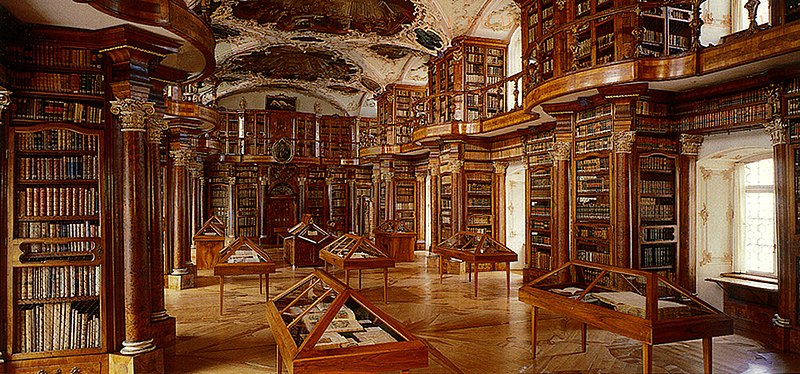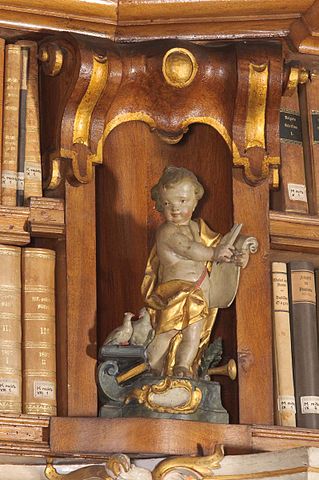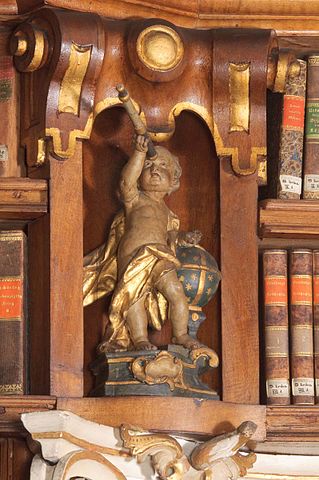The Abbey Library of St. Gall, Switzerland

Many librarians are virtuous people, but the Abbey Library of St. Gall in Switzerland was founded by a saint.
Its founder was Saint Othmar (c. 689 CE – c. 759 CE) a monk who served as first abbot of the Abbey of St. Gall, a Benedictine monastery in northeastern Switzerland. The city of St. Gall is located between Lake Constance and the mountains of the Appenzell Alps. The library contains over 160,000 manuscripts and other treasures, some of which have been scanned and made available online for readers to admire.
Although the Abbey of St. Gall was founded in the eighth century, the extant library building and abbey of St. Gall were constructed in the 1700s. Above the entrance is a Greek inscription reading Healing Place for the Soul. Reading and writing was essential to this order of monks, and for this reason, the Abbey Library of St. Gall, the oldest library in Switzerland, was been named a UNESCO World Heritage Site in 1983. Among its outstanding collection is the oldest surviving complete music manuscript in the world, produced at the Abbey circa in around the year 920 CE. The building was designed by the Austrian architect Peter Thumb, who in the 1700s created many masterworks in the graceful, elaborate, enjoyable style known as rococo.
Thailand and Switzerland
Thailand has long had significant ties to Switzerland. His Majesty King Bhumibol Adulyadej lived and studied there, as described in a new book in the TU Libraries collection, King Bhumibol and the Thai Royal Family in Lausanne: Recollections of HM King Rama IX’s Tutor.

Wider Switzerland–Thailand bilateral relations in recent years are due, according to the Swiss government, to the presence of Swiss companies in the Kingdom, tourism, Thai people who live in Switzerland, and Swiss people who live in Thailand. Thai people enjoy Swiss consumer and luxury goods as well as Swiss machinery and precision instruments for industry. In 2011, Switzerland was Thailand’s eleventh most important trading partner, making it the most important European trading partner. Switzerland is the number one destination in Europe for Thai tourists. In 2010, over 50,000 Thais visited Switzerland. The same year, 155,000 Swiss tourists toured in Thailand.
In recognition of these ties, the Swiss government offers Excellence Scholarships for Foreign Scholars and Artists to outstanding Thai postgraduates.
A friend in need.
After the December 2004 Indian Ocean tsunami, Switzerland was active in assisting the recovery and rebuilding process. This is natural, as since the end of 2011, almost 7000 Swiss nationals are full-time residents of Thailand, and over 2500 have dual Thai-Swiss citizenship. Thailand and Switzerland have been in close contact since the 1600s, when Swiss missionaries visited the kingdom of Siam.

Health matters.
More recently, medical tourism has been attracting some Swiss nationals to the Kingdom. As swissinfo.ch, the international service of the Swiss Broadcasting Corporation, reports, Swiss Alzheimer’s patients are being treated in Thailand. In Faham, a few kilometres outside Chiang Mai, the Baan Kamlangchay Centre, run by a Swiss national, treats patients with Alzheimer’s disease and other dementias. Located in six houses within one neighbourhood, Baan Kamlangchay hosts patients from Switzerland and Germany who at home would be heavily medicated in centers that are relatively costly. Dr. Martin Woodtli, the founder of the Baan Kamlangchay Centre, explains that
in Thailand the elderly enjoy great respect. It is considered normal that younger people take care of them.
With high esteem for Thai caregivers, Dr. Woodtli assigns three caregivers to each patient, which would not be economically possible in a care home in the West. The caregivers participate in all the activities of each patient, and one sleeps in the same room as the patient at night. This degree of care and attention is never seen in Switzerland or other western residences. At Baan Kamlangchay, Swiss patients are given traditional Swiss foods such as the breakfast food muesli made of oats, grains, fresh or dried fruits, seeds, nuts, and milk. Since 2003, around 70 Swiss people have lived at Baan Kamlangchay and currently about a dozen make the centre their home. Their families are charged 3,500 Swiss francs per month (124,382 baht) which is extremely expensive for Thailand but only one-third of the price of a care home in Switzerland. The Thai nursing staff are paid around 9,000 baht per month each. Larger projects are being planned by other investors in the Chiang Mai area, but these will likely feature less attentive care and fewer staff assigned to each patient.

(all images courtesy of Wikimedia Commons).
